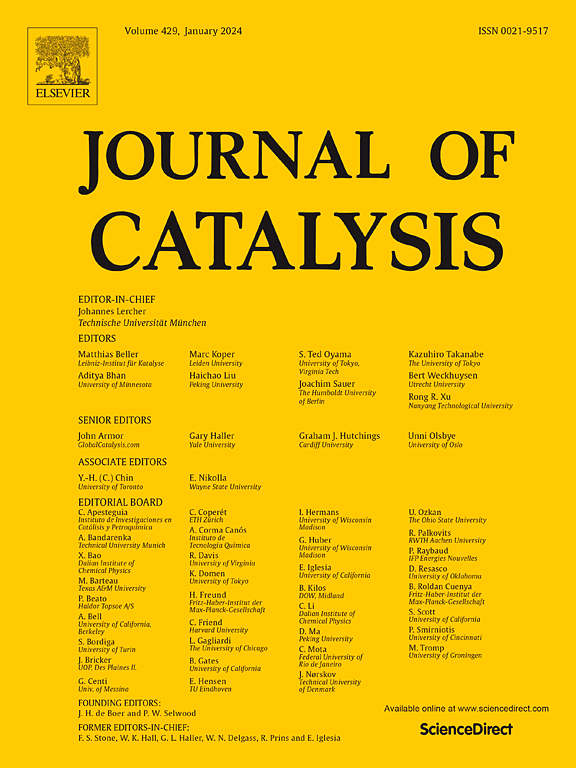Theoretical insights and predictions: Photocatalytic functionalization of C(sp3)−H bonds in methane using [W10O32]4−
IF 6.5
1区 化学
Q2 CHEMISTRY, PHYSICAL
引用次数: 0
Abstract
Methane activation catalyzed by [MW9O32]n− (n = 3–5) and [MW5O19]m− (m = 1–3) was investigated through Density Functional Theory (DFT) calculations. We identified the key active species, active site, and reaction mechanism by studying the model reaction of methane hydroalkylation catalyzed by [W10O32]4−. Systematic comparisons across modified polyoxometalates (POMs) revealed multiple electronic and structural descriptors governing methane activation efficiency. A key discovery involves the role of photoinduced surface-bridging oxygen holes in [W10O32]4−, which serve as active sites for cleaving the inert C(sp3)![]() H σ-bond. While other POMs, including [W6O19]2−, [PW12O40]3−, and [P2W18O62]6−, also exhibit methane-activating oxygen holes, their requirement for higher-energy UV excitation (compared to the visible-light-responsive [W10O32]4−) likely explains the latter’s broader utility in organic synthesis. Electronic structure analysis uncovered a near-linear correlation between triplet POM β-LUMO energies and C(sp3)
H σ-bond. While other POMs, including [W6O19]2−, [PW12O40]3−, and [P2W18O62]6−, also exhibit methane-activating oxygen holes, their requirement for higher-energy UV excitation (compared to the visible-light-responsive [W10O32]4−) likely explains the latter’s broader utility in organic synthesis. Electronic structure analysis uncovered a near-linear correlation between triplet POM β-LUMO energies and C(sp3)![]() H activation barriers. Crucially, the negative charge density of POMs inversely regulates β-LUMO energetics: lower anionic charges correspond to reduced β-LUMO energy levels and consequently lower activation barriers. This structure–activity relationship implies that strategic charge modulation in POM architectures can fine-tune frontier molecular orbital levels, thereby controlling catalytic performance in methane functionalization. Based on these principles, we propose the low-charge metal-substituted POM [ReW5O19]− as a promising candidate for X
H activation barriers. Crucially, the negative charge density of POMs inversely regulates β-LUMO energetics: lower anionic charges correspond to reduced β-LUMO energy levels and consequently lower activation barriers. This structure–activity relationship implies that strategic charge modulation in POM architectures can fine-tune frontier molecular orbital levels, thereby controlling catalytic performance in methane functionalization. Based on these principles, we propose the low-charge metal-substituted POM [ReW5O19]− as a promising candidate for X![]() H bond activation (X = S, C, N, O).
H bond activation (X = S, C, N, O).


[W10O32]4-催化甲烷中C(sp3)- h键的光催化功能化
通过密度泛函理论(DFT)研究了[MW9O32]n- (n = 3-5)和[MW5O19]m- (m = 1-3)对甲烷活化的催化作用。通过研究[W10O32]4-催化的甲烷加氢烷基化模型反应,确定了关键活性物质、活性位点和反应机理。对改性多金属氧酸盐(POMs)的系统比较揭示了控制甲烷活化效率的多个电子和结构描述符。一个重要的发现涉及到[W10O32]4-中光诱导表面桥接氧空穴的作用,这些空穴作为切割惰性C(sp3)H σ-键的活性位点。而其他pom,包括[W6O19]2-, [PW12O40]3-和[P2W18O62] 26 -,也表现出甲烷活化氧空洞,它们需要更高能量的紫外线激发(与可见光响应[W10O32]4-相比)可能解释了后者在有机合成中的广泛应用。电子结构分析揭示了三态POM β-LUMO能量与C(sp3)H激活势垒之间的近似线性关系。至关重要的是,POMs的负电荷密度与β-LUMO的能量特性成反比:较低的阴离子电荷对应于较低的β-LUMO能级,从而降低激活势垒。这种构效关系表明,POM结构中的策略性电荷调制可以微调前沿分子轨道水平,从而控制甲烷功能化的催化性能。基于这些原理,我们提出了低电荷金属取代POM [ReW5O19]-作为XH键激活(X = S, C, N, O)的有希望的候选物。
本文章由计算机程序翻译,如有差异,请以英文原文为准。
求助全文
约1分钟内获得全文
求助全文
来源期刊

Journal of Catalysis
工程技术-工程:化工
CiteScore
12.30
自引率
5.50%
发文量
447
审稿时长
31 days
期刊介绍:
The Journal of Catalysis publishes scholarly articles on both heterogeneous and homogeneous catalysis, covering a wide range of chemical transformations. These include various types of catalysis, such as those mediated by photons, plasmons, and electrons. The focus of the studies is to understand the relationship between catalytic function and the underlying chemical properties of surfaces and metal complexes.
The articles in the journal offer innovative concepts and explore the synthesis and kinetics of inorganic solids and homogeneous complexes. Furthermore, they discuss spectroscopic techniques for characterizing catalysts, investigate the interaction of probes and reacting species with catalysts, and employ theoretical methods.
The research presented in the journal should have direct relevance to the field of catalytic processes, addressing either fundamental aspects or applications of catalysis.
 求助内容:
求助内容: 应助结果提醒方式:
应助结果提醒方式:


